
If you’ve ever craved a dish that’s part comforting stew, part noodle wonderland, big plate chicken (大盘鸡, Da Pan Ji) is the answer. Born along the busy truck routes of northwest China, this filling one-pot meal was created to satisfy hungry drivers, and soon became a staple beloved all over the country.
At its core, big plate chicken features juicy, bite-sized chunks of chicken simmered in a richly spiced sauce with potatoes and peppers, then served over chewy hand-pulled noodles. The broth is flavored with bold aromatics like star anise, Sichuan peppercorn, dried chili peppers, and a splash of Shaoxing wine for depth. A dollop of doubanjiang adds just the right amount of heat and umami, while chunks of potato soak up all the savory goodness, creating velvety bites that are as comforting as they are flavorful.
Ingredients
The ingredient list for Da Pan Ji looks quite long, but most of it consists of pantry ingredients that you probably already have. Like any braised dish, this one uses a lot of spices and aromatics to create a balanced and complex sauce that is hearty and rich. Once you gather the ingredients, the dish is quite straightforward to make.

Which cut of chicken to use
In China, restaurants always use a whole chicken and chop it into bone-in, bite-size pieces. The reason is that the bones will make the broth extra flavorful and release gelatin to thicken the sauce naturally.
To make the recipe more suitable for a Western kitchen, I used boneless skinless chicken thigh pieces. Because thigh meat is much richer than breast, it pairs well with the rich sauce. It also handles the braising much better, soaking up all the flavor without turning dry.
If you are looking for a more authentic texture and mouthfeel, you can also consider using chicken wings. Or you can even use chopped up thigh and leg pieces (bite-size pieces). I do not recommend using chicken breast since it dries out too fast and it’s not suitable for braising.
Recommended noodles
What makes a restaurant Da Pan Ji really special is the hand-pulled noodles. Compared to packaged noodles, they are much chewier and have a special texture that dried noodles can’t compare to. I highly recommend using my hand-pulled noodles recipe if you want to pursue the authentic experience.
On the other hand, Da Pan Ji is quite straightforward to make despite its long list of ingredients, and you can totally serve it with packaged noodles for a weeknight meal.
If you have access to a large Asian or Chinese market, try to find the Shanxi Hand Pulled Noodles from Havista. It is a super wide noodle with a nice texture. If these are not available, I also recommend the Knife Cut Dried Noodles from The Mala Market. They are quite wide and have a nice chewy texture.

Flavor base
The dish uses chicken stock as a base. In an ideal world, you would use homemade chicken stock. Not only is it packed with flavor, it also creates a thick sauce texture. But of course, my recipe uses boxed chicken stock to simplify things. The result tastes just as good, but the sauce is a little thinner than one you’d have in a restaurant.
Shaoxing wine, light soy sauce, dark soy sauce, and a small amount of doubanjiang create an earthy savory umami with some heat. Dark soy sauce gives the dish a nice dark color and a bit of caramel taste.
An array of spices and aromatics are used – ginger, garlic, scallion, dried chili pepper, star anise, bay leaf, cinnamon, and Sichuan peppercorn. They give the dish a warm tone with a complex flavor and some smokiness.
Like other dishes from Xinjiang cuisine, the dish uses onion, potato, and pepper, which are staples in the region. They add texture and make the dish hearty, colorful and filling.
How to make
1. Prep the noodles: If you’re making fresh hand-pulled noodles, prepare the dough first. For dried noodles, boil them until al dente. Rinse them under cold water and drain well. If you use the Shanxi Hand Pulled Noodles from Havista, separate them and add to the boiling water one noodle at a time to prevent sticking (it’s the same method you’d use to cook fresh hand-pulled noodles.)
2. Brown the chicken: Heat the oil in a wok until smoking. Add the chicken pieces and cook until lightly golden. The key is not to touch the chicken for a minute or two before stirring, so the bottom browns properly without sticking.
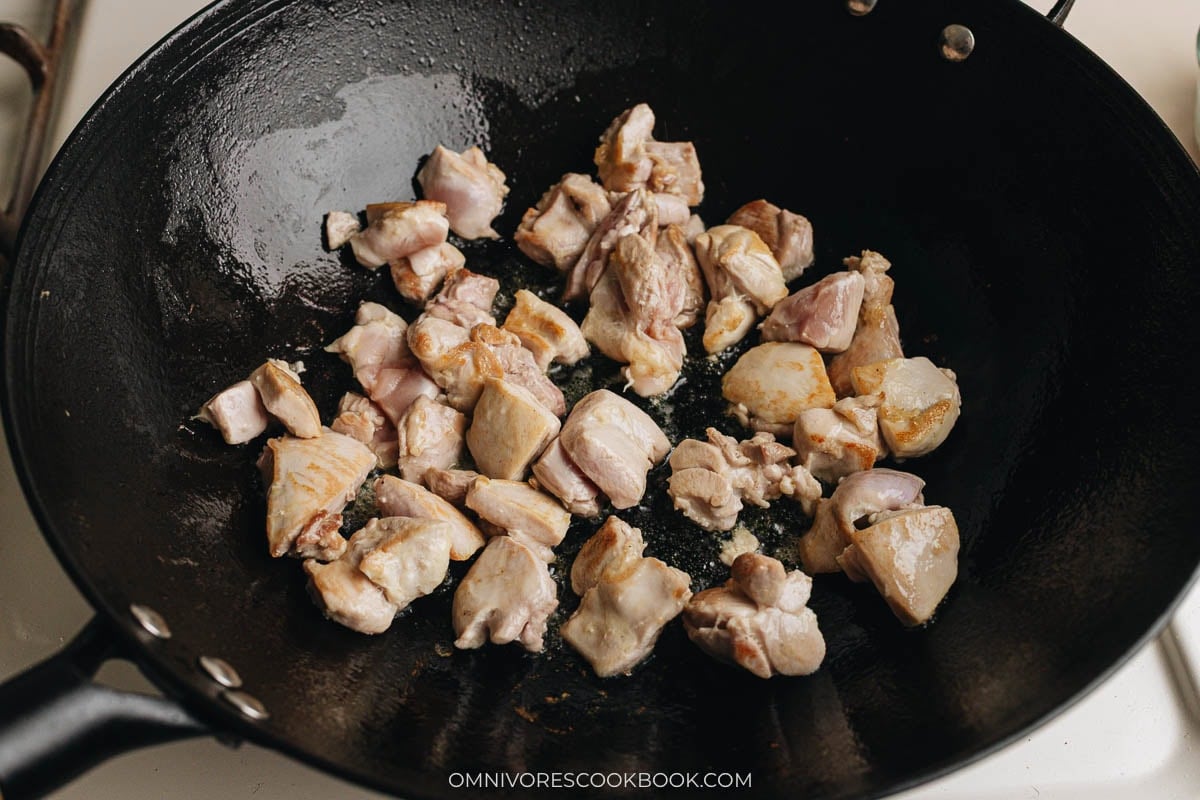
3. Bloom the aromatics: Add the ginger and spice mixture. Stir to infuse the oil. Then add doubanjiang and cook until it releases red oil.
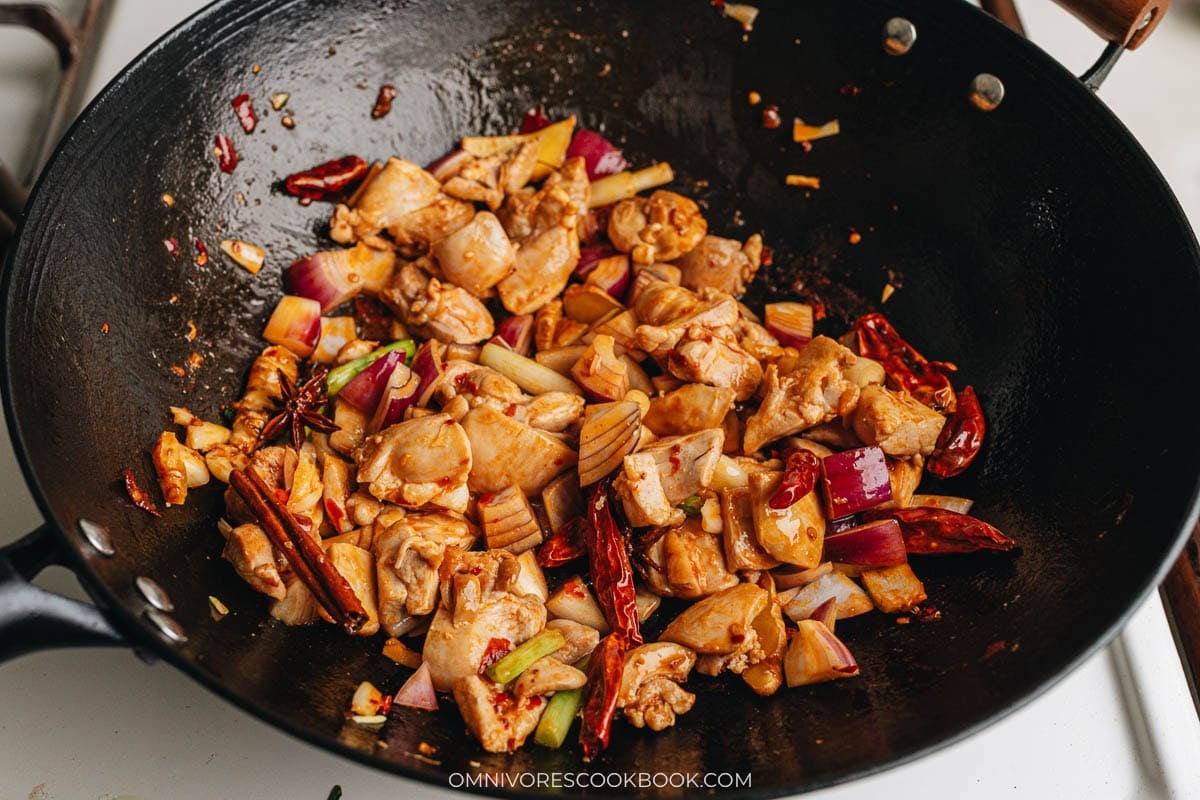
4. Deglaze and simmer: Pour in the soy sauce based seasoning mixture and scrape up any browned bits. Add chicken stock and potatoes. Bring to a simmer, cover, and cook for five minutes. During this process, you should let the broth maintain a boil, to let some liquid evaporate and for the fat to emulsify, to create a thicker sauce.
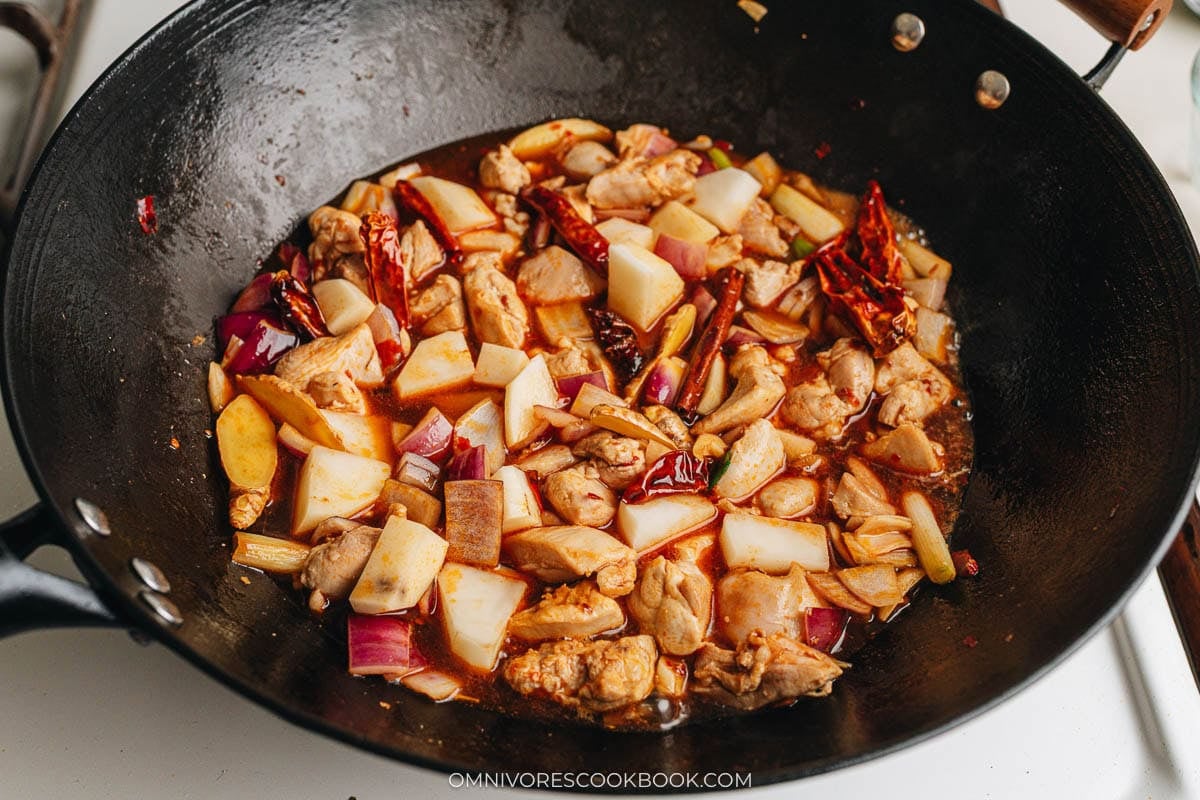
5. Add pepper: Stir in the red bell pepper and continue simmering for another five minutes until the vegetables are tender. If the sauce is too thin, cook uncovered over high heat while stirring until slightly thickened. But also pay attention not to reduce the broth too much, since the sauce tends to thicken more once it cools off.
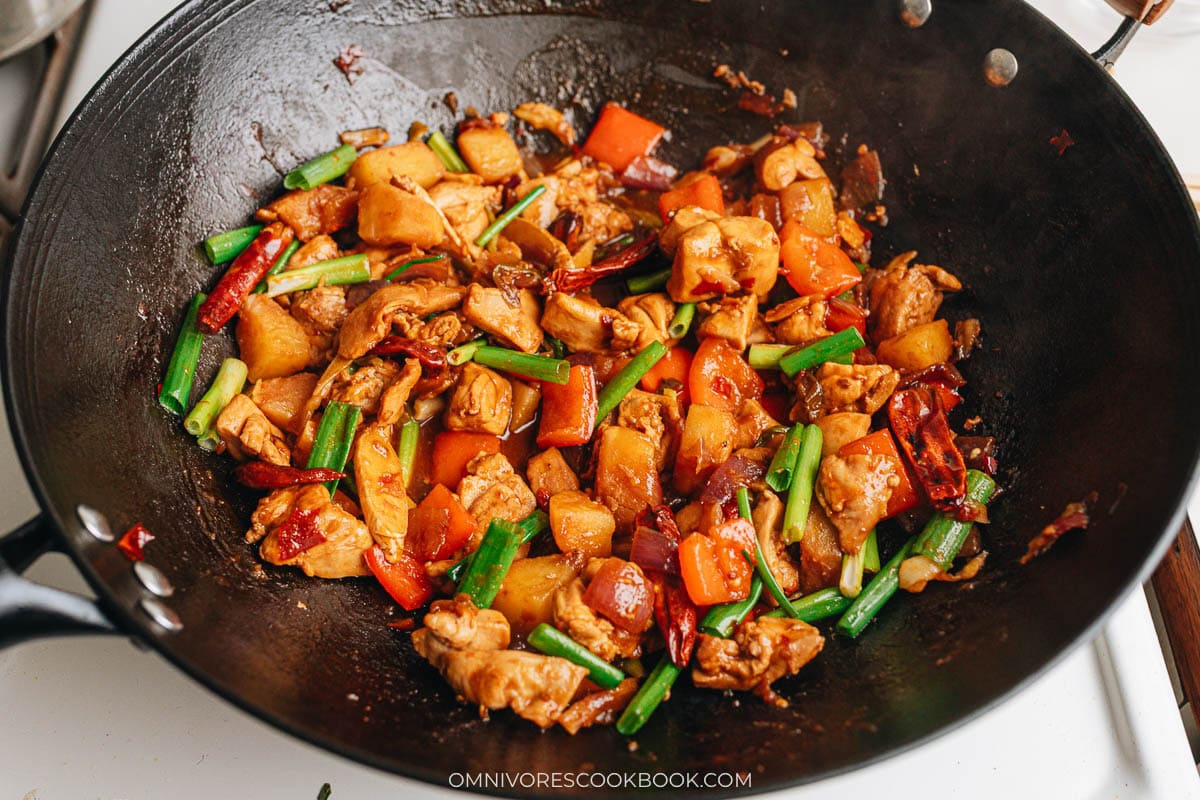
To serve, pile the chicken and vegetables along with the sauce over the noodles and serve immediately.
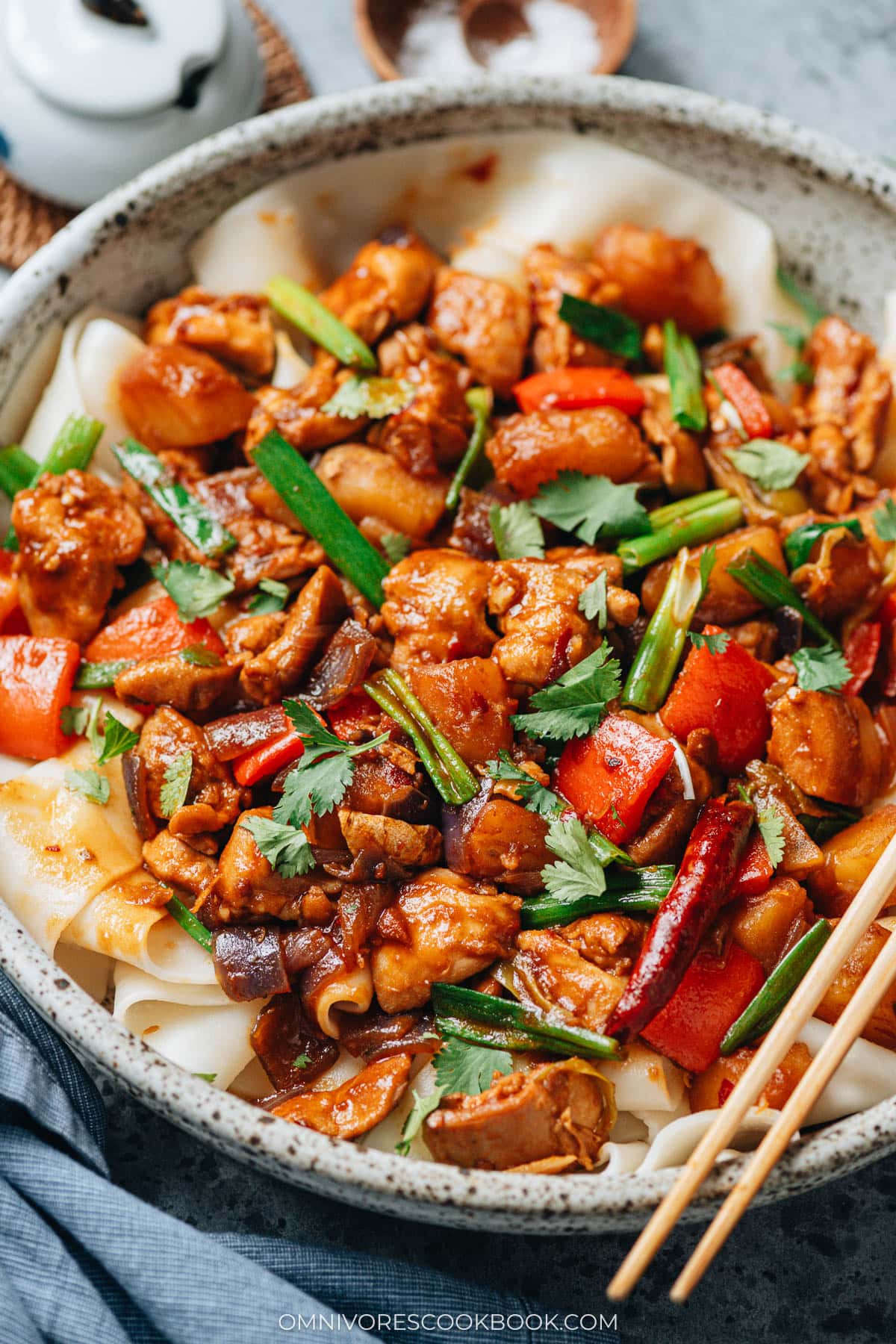
Wok is the best option for Da Pan Ji
Not only is a wok great for searing the chicken, the shape is also great for braising. This dish only needs a short braising time, a total of 10 minutes. By using the wok, we can use a small amount of liquid to braise all the ingredients, which creates a richer flavor and thicker sauce. If you don’t have a wok, a large deep skillet is also a great option.
How to Serve & Customize
- Serve big plate chicken family-style as a main dish in a large bowl for everyone to dig in, just as it’s done in China.
- If you want to make a Xinjiang-themed dinner party, consider pairing it with other dishes such as Kao Bao Zi (Baked Buns), Lamb Skewers, or Roast Lamb Shank. Don’t forget include Wood Ear Mushroom Salad or Cucumber Salad as a refreshing appetizer.
- To make it spicier, cut the chili peppers in half and use the seeds in the cooking. You can also use fresh chili pepper to replace the bell pepper. When serving the dish, add a splash of chili oil or chili crisp to your individual bowls according to your taste.
- Another frequently used ingredient is Chinkiang vinegar, which is a popular condiment to add to individual bowls to further enhance flavor.
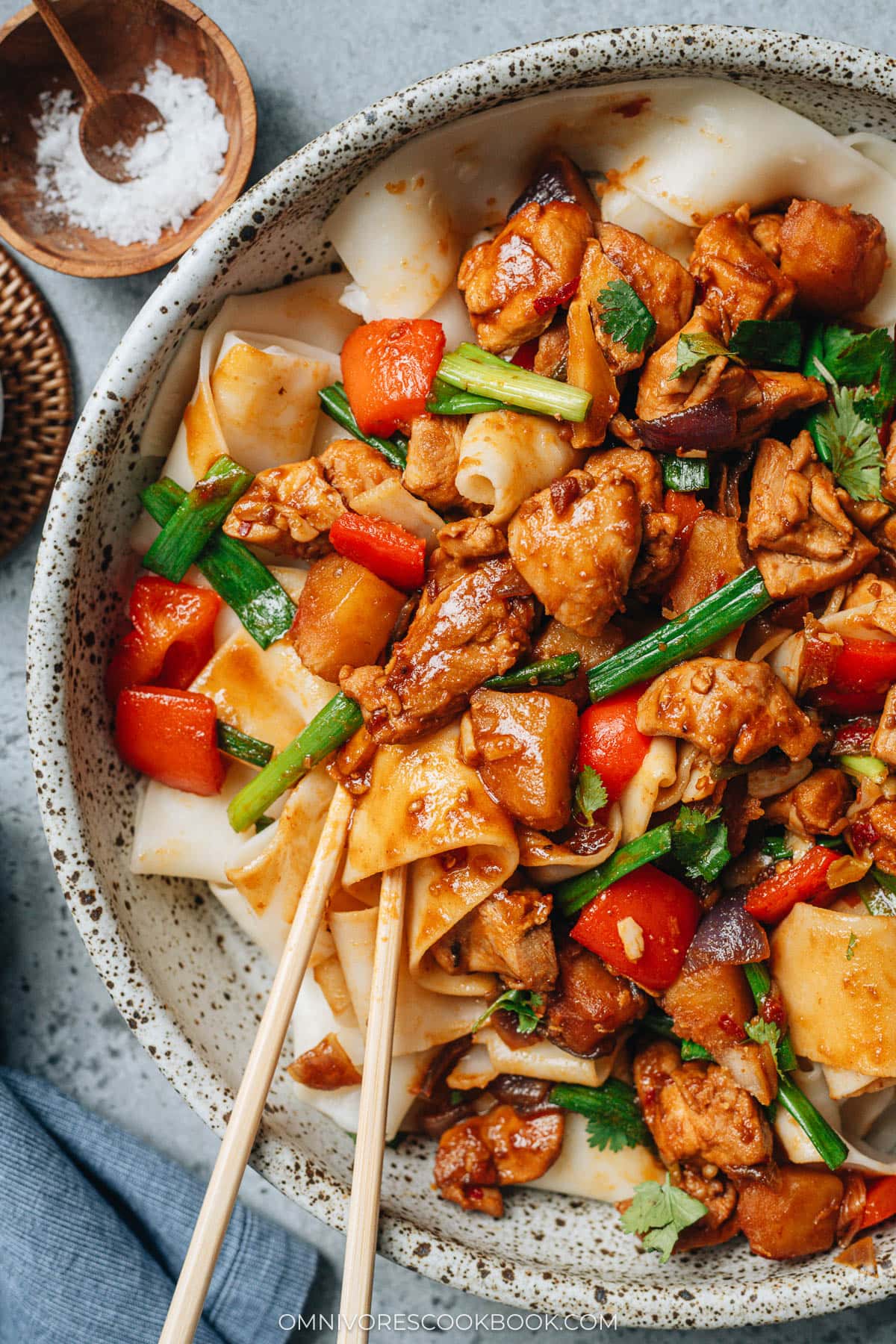
Frequently asked questions
Can I use bone-in chicken?
Yes. bone-in pieces will create richer flavor but will require a slightly longer simmering time. Start with 2 cups of chicken broth if using bone-in pieces, and braise for a total 15 to 20 minutes.
Can I replace the noodles with rice?
Absolutely. Big plate chicken tastes great served with steamed rice.
Can I use more chicken broth to create more sauce?
You can, however, the sauce will come out quite thin since this recipe thickens the sauce by reducing the liquid.
Da Pan Ji served at Chinese restaurants often comes with a bit more sauce and it’s thick. Because restaurants use homemade stock that is naturally thick due to the collagen in the stock.
If you really want more sauce with a thick texture, what you can do is to use 2 cups of chicken stock, and mix 1 tablespoon of cornstarch with 1 tablespoon of water to make a cornstarch slurry to thicken the sauce at the end of the cooking.
Chinese Cooking Made Easy
Are you new to this website? This free email series is a great place to start. I’ll walk you through a few of my most popular recipes and show you how and why they work. You’ll quickly start to cook better Chinese food in your own kitchen.

Da Pan Ji (Big Plate Chicken, 大盘鸡)
Ingredients
- 1 batch wide homemade pulled-noodles (or 8 oz / 225 g dried noodles)
- 2 tablespoons Shaoxing wine
- 2 tablespoons light soy sauce
- 2 teaspoons dark soy sauce
- 1 tablespoon doubanjiang
- 1 teaspoon sugar
- 1 thumb ginger , thinly sliced
- 6 cloves garlic , smashed
- 4 scallions , sliced into 1” pieces
- 1/2 red onion , sliced into 1/2” pieces
- 8 dried Chinese chili peppers
- 2 star anise pods
- 2 bay leaves
- 1/2 teaspoon ground Sichuan peppercorn
- 1 cinnamon stick
- 2 tablespoons peanut oil (or vegetable oil)
- 4 boneless chicken thighs , diced to 1” (2.5 cm) pieces
- 1 1/2 cups chicken stock
- 1 russet potato , roll cut into 1/2” pieces (*Footnote 1)
- 1 red pepper , cut into 1 1/2” pieces
- Chopped cilantro for garnish (Optional)
Instructions
- Prepare the noodle dough if you’re planning to use homemade noodles.
- Mix Shaoxing wine, light and dark soy sauce, and sugar in a small bowl.
- Add the ginger, garlic, onion, dried chili pepper, star anise, bay leaves, Sichuan peppercorns, and cinnamon to a small plate.
- Boil the noodles according to instructions. Once done, drain and rinse with cold water to stop cooking. Then drain again.
- Heat oil in a wok until shimmering. Add the chicken. Cook, stirring occasionally, until the surface turns light golden.
- Add the plate of the spices to the wok. Stir and cook for 30 seconds to release fragrance. Add doubanjiang and cook until all the spices are coated. Add the Shaoxing wine mixture. Stir immediately to deglaze the wok.
- Pour in water and add potato. Cook over medium-high heat until bringing to a simmer. Cover and simmer over medium heat for 5 minutes (*Footnote 2).
- Add bell pepper. Keep simmering for another 5 minutes until the vegetables turn tender. Stir in the scallion and cook for another minute.
- If the broth is still too thin, turn to high heat to reduce the sauce. Stir constantly to prevent burning. Once done, transfer everything to a big bowl. Remove as much dried spices as you can and discard them.
- Serve the chicken, vegetables and sauce over boiled noodles. Garnish with cilantro if desired.
Notes
- Hold your knife at about a 45 degree angle relative to the potato. Cut 1” from the end. Roll the potato towards you until the cut side is facing up then cut again 1” from the end at the same angle. Repeat the rolling and cutting. All the potato pieces should be roughly triangular in shape. This is a common knife technique in Chinese cooking, to create more edges on tougher vegetables so they soak up flavor while braising.
- The broth should retain a low boil, so the sauce slowly reduces, and thickens up as the fat emulsifies.
Nutrition

Did you make this recipe?
I’d love to hear how it turned out for you! Please take a moment to leave a 5-star rating ⭐️ and share your thoughts in the comments further down the page. It really helps others discover the recipe too.

Judith Henry
This was wonderful! The spice flavors and “heat” from the peppers was perfect!
Thank you for another fabulous recipe.
Rachael Nikkola
I have not made yet, however, I’m confused about everyone asking about what kind of beer is used in this recipe. I don’t see ANY beer mentioned in recipe or in detailed description of making recipe! What is going on?? I’m just curious?
Maggie Zhu
Hi Rachael, the current recipe is an updated version from my previous recipe. I used to use beer in this dish but not anymore. Sorry about the confusion.
Swati
What is the serving size for the nutritional information
Sally
Question on what beer to use? Is there a certain type that I should use?
Maggie Zhu
I didn’t call for a certain type of beer but a light Lager would work well. I would avoid any dark beer that has a very strong taste.
Jade
Hi Maggie :-> I love your recipes! The flavors in this one really interest me but I’m not a big fan of doubanjiang. Would this recipe still be tasty if omitted or would it not really come together? Is there a good sub for the strong flavor of the fermented beans, maybe mushrooms…? Thanks!!
Maggie Zhu
I think if you have fermented beans (or the fermented bean sauce) that will be a great replacement 🙂
Sara Jane
I love your website. I’m a bit of an adventurous cooker and I get so bored of recipes. I don’t have much experience with Chinese cooking but I have lots of access to ingredients (similar at least) in Vietnam. I can’t wait to try them!
Selina
Wonderful home coking recipe. Thank you for this dish. I get many ideas/recipes from you to cook for my family. It brings me memories of my mother’s Chinese home cooking dishes.
Kay
What would be a good substitute for the beer? I never have it on hand at home.
Maggie
Hi Kay, you could substitute the beer with 1 cup chicken broth plus 2 tablespoons Shaoxing wine (or dry sherry). If you don’t any alcohol at home, 1 cup chicken broth works too. Alcohol adds a nice tanginess to the dish but you can do without.
dia
Maggie,
I’ve been following your recipes for time and I was really excited to see Xin Jiang cuisine because thats where my home town is. Dapanji is celebrated dish, and it is great for capturing the history of Xin Jiang, the dish was created by a Sichuan man who came to work in Urumqi, Xinjiang ( home to the ethnic indeginous peoples of chinas north west the Uyghurs) and was first sold at a Hui Zhou (Chinese muslim) restaurant. I think your dish looked beautiful i made it last night and it was very tasty, however it is not dapanji.
I understand that your dish was created for the sake of being accessible to different people. But by doing so i dont think it kept the qualities that make dapanji, dapanji. Even when I eat at Uyghur and Chinese restaurants in the states and Canada it always has the same components to it, as it did back home. Wherein, The chicken should be cut into smaller pieces, as dapanji literally translates to big plate chicken, it would not be dapanji without a dish of succulent pieces of chicken on the bone. traditionally the noodles are only used with the broth after wards. Im also sad to see the use of alchohol as because a majority of us are muslim in the north west, the original recipe never had alcohol, so much so that the annual dapanji festival in xinjiang discourages the use of alcohol so all the competing dapanji dishes will have a fair shot. also we dont use bell pepper, we use sichuan peppers and long green chinese peppers, and sugar and soy sauce are also used to give a sweet and spicy after taste and makes the broth of the chicken very thick- which takes us to the name “chicken potato stew”- although water and oil are used to create the broth the chicken should be cooked until it no longer is a stew but a minimal thick liquid coat (aided by the potatos) that coat your noodles after you finish the chicken. I also wanted to add that we dont use fermented beans either.
I hope you dont take my comment with malice, but this dish is very important to our people and it really celebrates the identity and unison of xinjiang and i hope you will consider making the dish in the tradition way to see how it tastes and if you life it! best wishes maggie,
Dia
Wendy van Driel
So goood! Thank you so much for your contribution to and introduction in the real chinese kitchen…I have a ton of international cook books, but a real chinese one was not among them.
Aoife Hanley
OMG this is phenomenal. Tastes just like the real deal, thank you so much for the recipe! Look forward to exploring the rest of your site 🙂
Mili
Hey Maggie,
its great you’re shinning a light on Uighur cuisine! Im loving seeing more and more of it on english blogs. However, for this recipe in particular, I recommend to not ever use bell peppers, and only use long hot green Chinese peppers, and the use of beer is not needed. It is a Uighur recipe (who are Islamic) and using alcohol in cooking is just not a thing.
Caramelizing the chicken with the sugar and soy sauce is also really needed to get that rich colour, everything else is a great adaptation! Hope to see more Xingjiang recipes 🙂
Beth
Do you recommend using a certain kind of beer?
Albert Bevia
I have never heard of this “big plate chicken”, but dang it looks so amazing! I can see why this is served in so many Xinjiang restaurants. So many great flavors you added to this dish….incredible recipe
Danielle
Maggie, this sounds amazing! I do hate cutting up a whole chicken though, so I’ll totally go the legs and thighs route. And I’m very excited to have a reason to go pick out some fresh noodles at the market! maybe someday I’ll try the hand pulled noodles 🙂 There’s this place I like to eat at that serves fresh hand pulled noodles and they are SO GOOD. One of my favs.